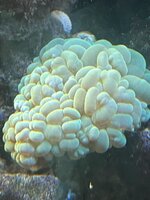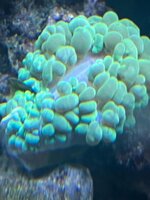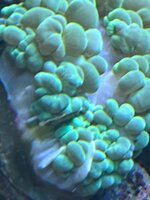Bubble Corals are some of my favorite corals. My large bubble coral is better and seems to be doing okay today (picture attached), however about a week ago I noticed that on one side is a bony spike with green on it (picture attached). That side appears to be the weaker side when it is inflated. I was happy to see that today it was almost fully inflated. I feed it small pink shrimp that I get from the pet store. IS there anything that I need to do regarding the green boney spike? I have a 65 gallon ocean view aquarium.
-
Welcome back Guest!MARSH is a private reefing group. Comments and suggestions are encouraged, but please keep them positive and constructive. Negative threads, posts, or attacks will be removed from view and reviewed by the staff. Continually disruptive, argumentative, or flagrant rule breakers may be suspended or banned.
Bubble Coral Question (1 Viewer)
- Thread starter ldian
- Start date
- Tagged users None















